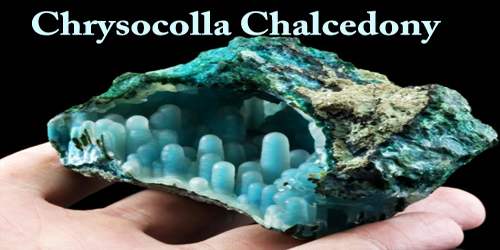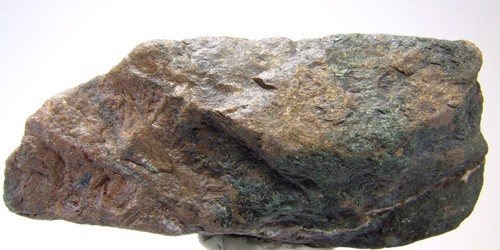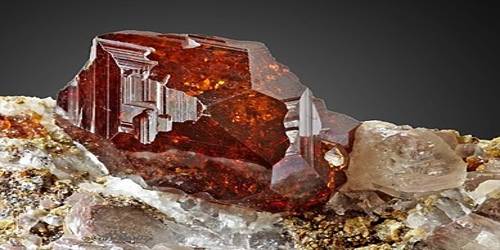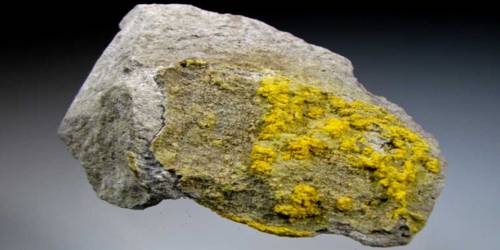Definition –
Chrysocolla Chalcedony or “gem silica chrysocolla” is a hydrated copper phyllosilicate mineral with formula: Cu2−xAlx(H2−xSi2O5)(OH)4·nH2O (x<1) or (Cu,Al)2H2Si2O5(OH)4·nH2O. It is often known as “Gem Silica”, which is a bluish-green to a greenish-blue variety of chalcedony that receives its vivid color from the presence of copper. The structure of the mineral has been questioned, as spectrographic studies suggest material identified as chrysocolla may be a mixture of the copper hydroxide spertiniite and chalcedony.
Chrysocolla, it is actually a member of the chalcedony family and not, strictly speaking, a variety of chrysocolla at all.
Chalcedony is a type of aggregate quartz. When most people think of quartz, they think of macrocrystalline quartz, which includes amethyst, citrine, ametrine, and smoky quartz. Yet many varieties of quartz are cryptocrystalline; they have microscopically (or submicroscopically) small crystals and are usually translucent to opaque, with a waxy, greasy or dull luster. This kind of quartz has fibrous and granular subcategories. The fibrous varieties are known under the general name of chalcedony, while the granular varieties are known as jasper.
Gem silica is the most valuable variety of chalcedony, with quality cut gemstones selling for over $100 per carat. The best specimens have a pleasing blue color with strong saturation, a uniform translucence, and a lack of inclusions.
Even though gem silica is one of the most beautiful blue gemstones, most people have never heard of it. That is because it is a very rare gem. It is seldom seen in jewelry and is used mainly by a small number of high-end jewelry designers.
The name comes from the ancient Greek χρυσός (chrysos) and κολλα (kolla), “gold” and “glue”, in allusion to the name of the material used to solder gold, and was first used by Theophrastus in 315 BC.
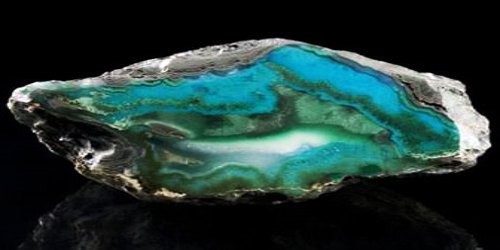
Geology of Chrysocolla Chalcedony (Gem Silica) –
Chrysocolla has a cyan (blue-green) color and is a minor ore of copper, having a hardness of 2.5 to 7.0. It is of secondary origin and forms in the oxidation zones of copper ore bodies. Associated minerals are quartz, limonite, azurite, malachite, cuprite, and other secondary copper minerals. It is typically found as botryoidal or rounded masses and crusts, or vein fillings. Because of its light color, it is sometimes confused with turquoise.
Gem silica is always associated with copper deposits. It is a secondary mineral that forms as cavity linings and fracture fillings in the rocks above and adjacent to copper deposits. It is even known to occur as a mineral lining in geodes. Its occurrence, habits, and deposit geometries are like any other type of chalcedony. Commonly associated minerals include quartz, chalcedony, chrysocolla, and malachite. Deposits are usually small in size and volume. It is a material produced by the gram rather than by the ton.
Notable occurrences include Bacan Islands, Indonesia, Israel, Democratic Republic of Congo, Chile, Cornwall in England, and Arizona, Utah, Idaho, Colorado, New Mexico, Michigan, and Pennsylvania in the United States.
The Miami-Inspiration Mine in Arizona is the best recent source of high-quality gem silica. The Keystone Copper Mine in Arizona produced notable amounts of gem silica in the early 1900s. Gem silica has been produced occasionally and in limited amounts from locations in New Mexico, Mexico, Peru, Taiwan, and the Philippines.
The natural productivity of the gem silica gemstone is decreasing which is making it hard to meet the growing demand almost every single day. The deposits of this gemstone are in their least quantities and mostly near copper deposits. This gemstone is said to be associated and resemble quartz, malachite, chalcedony. Though they all resemble alike, they have different properties quite different from each other.
A 2006 study has produced evidence that chrysocolla may be a microscopic mixture of the copper hydroxide mineral spertiniite, amorphous silica, and water. High-quality specimens of gem silica are translucent to transparent and highly saturated in color, with excellent color consistency and clarity. They combine the attractive color of chrysocolla with the superior hardness of chalcedony quartz.
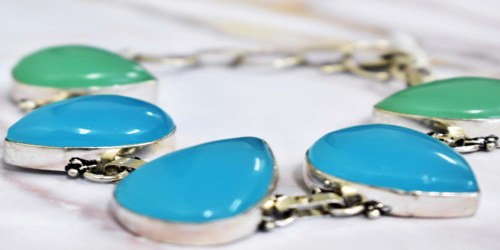
Uses and Healing Properties –
Chyrsocolla is first and foremost a Stone of Communication. Its very essence is devoted to expression, empowerment, and teaching. The serenity of its turquoise-blue color discharges negative energies, calms, and allows truth and inner wisdom to surface and be heard. A peaceful stone, it emphasizes the power our words and actions have on those around us and encourages compassion and strengthening of character.
Due to being somewhat more common than turquoise, its wide availability, and vivid, beautiful blue and blue-green colors, chrysocolla has been popular for use as a gemstone for carvings and ornamental use since antiquity. It is often used in silversmithing and goldsmithing in place of turquoise and is relatively easy to work and shape. Chrysocolla exhibits a wide range of Mohs hardness ranging from 2 through 7, which is dependent on the amount of silica incorporated into the stone when it is forming. Generally, dark navy blue chrysocolla is too soft to be used in jewelry, while cyan, green, and blue-green chrysocolla can have a hardness approaching 6, which is similar to turquoise. Chrysocolla Chalcedony is a heavily silicified form of chrysocolla that forms in quartz deposits and can be very hard and approach a hardness of 7.
This gemstone is well known to heal the body through vibrational healing techniques. This is one of the most common and divine methods opted by a lot of people to get themselves cured. This is the most desirable one but a lot of people find it hard to connect with the vibrations of healing. The gem silica stone helps people with it. The stone is also known to enhance the activity or the activeness of the most crucial chakra of the body i.e. the throat chakra. The stone after coming in contact with the skin helps in making your career visions clear and easy to achieve the same.
Good quality chalcedony cabochons in other colors typically sell for prices in the range of $3 to $5 per carat. However, prices for top-grade gem silica can reach as high as $100 per carat. Buyers considering this highly-priced material should also consider chrysoprase, a vivid green type of chalcedony that is still affordably priced.
Information Sources:
